Results of the Questionnaire Survey in the Developments of the Municipal Housing Stock of Selected Towns (2002, 2003)
by Jaroslav Kubečka and Helena Potůčková; Ministry of Regional Development
Dana Chlupová, Marie Polešáková and Ludmila Rohrerová; Institute for Spatial Development
In 2004, the Brno Institute for Spatial Development carried out the 5th questionnaire survey on the development of municipal housing stocks, collecting and upgrading the necessary data and information in selected towns and cities of the Czech Republic. Based on the requirements of the assignor of the research — the Housing Policy Department of the Czech Ministry of Regional Development — this year’s research has kept to the same batch of 50 towns and cities as last year. So, addressed was the capital plus some of its districts, the 19 statutory cities, and 30 towns — see the Map of Addressed Towns. As in previous years, the questionnaire survey was aimed at the exploration of 5 kinds of data which are usually not explored by the Czech Statistic Office: privatization of the municipal housing stock, shifts within the municipal housing stock, payments for the usage of the municipal housing stock, maintenance costs of the municipal housing stock, and additional data.
As additional data, items related to housing were added, such as the filing system of the demand for municipal dwellings and the criteria of allowance, the approach to rent debtors and the means of decreasing their debts, the approach to the homeless, the participation of the private sector in the financing of new municipal dwellings, and the construction of unsubsidized new municipal dwellings. Newly surveyed this year was how municipalities observe independent households of no dwellings on their own and whether municipalities regularly check the demand for dwellings. Also, the respondents could indicate their recommendations as to what the questionnaire should be aimed at next year.
In active participation of the responding municipalities, the research has surveyed a total of 303,603 dwellings, representing thus 7.9 % of 3,828,912 dwellings of permanent inhabitation in the Czech Republic and 46.4 % of 655,000 municipal dwellings in the country.
The main objective of the research was to investigate in the actual results of the ongoing privatization of municipal dwellings, started in 1991.
Municipal housing stock privatization in selected towns
The development of the privatization, started with the transfer of the housing stock from the State to Municipalities in 1991, is shown in Diagram 1, Development of municipal housing stock privatization in selected towns, 1991–2003.
The Diagram indicates that 45 % of all the dwellings transferred to the ownership of Municipalities were privatized before the end of 2001, 51 % before the end of 2002, and 56 % before the end of 2003.
The development of the total numbers of municipal dwellings (including those newly built) in the towns under observation between 1991 and 2003, and the supposed situation after the termination of the privatization, is shown in Diagram 2, Development of total number of municipal dwellings (including recent constructions) between 1991 and 2003, and the supposed situation after the privatization of the municipal housing stock.
The percentage of the dwellings which the Municipalities intend to keep in their ownership is related to the overall number of dwellings transferred from the State to Municipalities in 1991.
Diagram 1
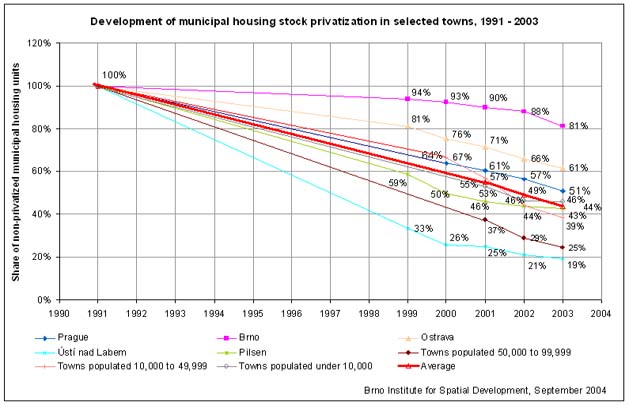
Diagram 2
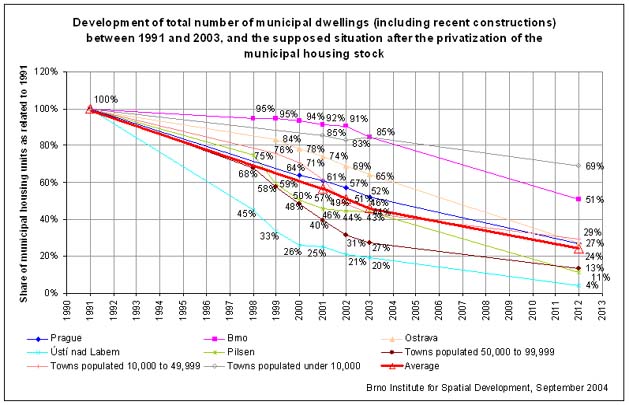
Data on privatization processes in Prague and Ústí nad Labem apply to selected city Districts only.
New constructions
Of the total number of municipal dwellings constructed between 1991 and the end of 2003, 72.9 % were built before the end of 2001, 12.6 % during 2002, and 14.5 % during 2003.
Diagram 3, Municipal dwellings completed between 1991 and 31 December 2003 in towns and cities under observation, shows the totals of newly constructed dwellings between 1991 and 2003, as per 1000 inhabitants, in Prague, Brno, Ostrava, Ústí nad Labem, Pilsen, and the 3 size categories (by the 30/1995 Regulation of the Ministry of Finance, amending the 176/1993 Regulation on Rentals) of the rest of towns under observation.
Diagram 3
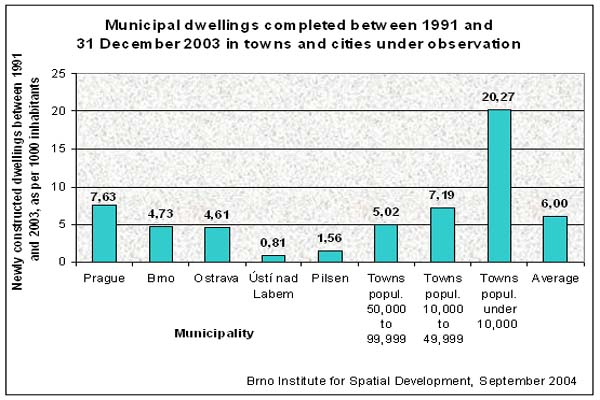
The structure of the recently built municipal dwellings is shown in Chart 1, Structure of newly constructed municipal dwellings, completed in 2002 and 2003.
Chart 1
| Municipality | % of newly constructed municipal dwellings, accepted in 2002 | % of newly constructed municipal dwellings, accepted in 2003 | ||
| in newly constructed buildings | in reconstructed buildings | in newly constructed buildings | in reconstructed buildings | |
| Prague | 79 | 21 | 86 | 14 |
| Brno | 5 | 95 | 35 | 65 |
| Ostrava | 24 | 76 | 29 | 71 |
| Ústí nad Labem | 0 | 100 | 0 | 100 |
| Pilsen | 0 | 100 | 89 | 11 |
| Towns populated 50,000 to 99,999 | 75 | 25 | 96 | 4 |
| Towns populated 10,000 to 49,999 | 80 | 20 | 62 | 38 |
| Towns populated under 10,000 | 91 | 9 | 58 | 42 |
| Average | 67 | 33 | 78 | 22 |
Developments of the total of municipal dwellings between 1991 and 2003
Between 1991 and the end of 2001, the total number of municipal dwellings decreased by 43.1 %. Between 1991 and the end of 2002, the decrease was of 49.2 %. Between 1991 and the end of 2003, the decrease was of 53.6 % of the total of municipal dwellings. In the course of 2002, there was a decrease of 10.6 % as related to 2001. In the course of 2003, there was a decrease of 8.7 % as related to 2002.
Estimated termination of the privatization of municipal dwellings
Most respondents have supposed to finish the privatization of municipal dwellings in 2004 and 2005, possibly 2006. The latest of the mentioned terms was 2010 and 2012. Some respondents have not mentioned any assumption or say they have no deadlines. Ten respondents had terminated the privatization before the survey, i.e. the towns of Kdyně (1997), Třebíč (1998), Most (1999), Tišnov (2000), the Prague Districts of Horní Počernice and Prague 8 (2002), the Ostrava District of Polanka nad Odrou, the District of Prague 13, and the towns of Kyjov and Polička in 2003. Privatization has reached a very advanced stage in Ústí nad Labem where 81 % dwellings have been privatized since the 1991 transfer. It is mainly the socially handicapped families who live in the flats which have not yet been privatized, which might be in relation to the high rate of debtors in municipal flats.
Share of municipal dwellings
The comparison of the numbers of municipal dwellings and the total of dwellings, as given by the censuses of 1991 and 2001, is shown in Diagram 4, Share of municipal dwellings in selected towns in 1991, 2002, and 2003.
The share of municipal dwellings is gradually decreasing. In 1991, 39.0 % of all dwellings were municipal. In 2001, 19.4 %; in 2002, 17.1 %. Finally, in 2003, 15.5 % of all dwellings in the towns under observation were municipal.
Diagram 4
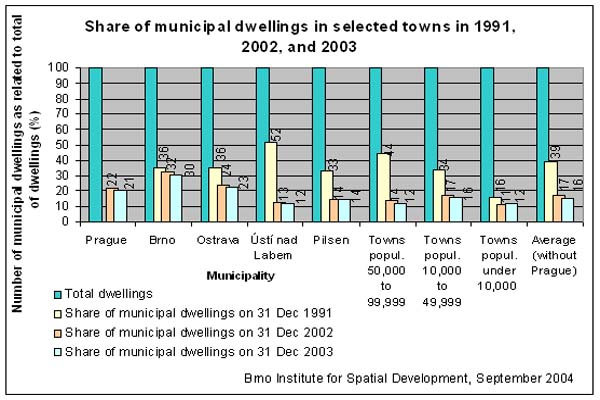
Numbers of municipal dwellings in 2002 and 2003 were compared to totals of dwellings as per the 2001 census.
Numbers of dwellings the Municipalities intend to keep in their ownership
The percentage of dwellings the Municipalities intend to hold in their ownership, as related to those transferred in 1991, is 24.3; while as related to the total number of municipal dwellings (including new constructions) at the end of 2003, such share is of 53.0 %.
General comments on the results of the municipal housing stock privatization
- In most towns, there was large demand for the privatization of the housing stock, sometimes very intensively so. The cities of Prague and Pilsen is where the demand is reported the largest. It is only the city of Ostrava where indifference prevails. Where privatization is unwanted is the Brno District of Tuřany (with only a few municipal dwellings, though).
- Mostly used as technical documentation in the process of housing stock privatization is the house passport and the revision reports (such as for electricity, elevators, heating units, fire protection, and so forth). If available, the planning documentation of the building is used, too.
- Technical conditions of the house seldom make difference in the statements of the Municipalities. Two city Districts of Ostrava, one of Prague, and the town of Dačice say they have been privatizing buildings in good technical conditions. The reports of one district of the city of Ústí nad Labem and the town of Svitavy say reconstructed buildings in good technical conditions are privatized, as well as those in poor technical conditions, which may also indicate that both of the last respondents do not distinguish the conditions at all.
- The respondents’ answers indicate that if the tenants show lack of demand for the municipal flat or house they live in, the dwellings are often offered and sold to third parties.
- The city of Prague has designed and acclaimed the Concept of the housing policy for 2000 and the oncoming period.
- The city of Brno has designed and acclaimed its Housing strategy for 2001–2011.
- The city of Ostrava is currently designing the Concept of the housing policy.
- The districts of Ústí nad Labem have not designed any concept of the housing policy yet, nor is any document of such kind being prepared.
- The Municipality of Pilsen has designed the Amendment and new directions of the housing policy, in force ever since 1999.
- Of other cities and towns, 38 % have designed and acclaimed their housing concepts or other documents, independent or as parts of other documents (Olomouc, Hradec Králové, Pardubice, Karviná, Děčín, Jablonec nad Nisou, Cheb, Otrokovice, Svitavy, Český Krumlov, Polička, Přerov, Chomutov, Znojmo, Písek, Holice, Brtnice). The city of Most has transferred a major part of the housing stock to a corporation operating according to annual business plans, while the Municipality’s focus is on the support to those who build houses on their own (plot sales, network construction). Twenty-two percent are working on their documents (Liberec, České Budějovice, Havířov, Zlín, Kladno, Karlovy Vary, Mladá Boleslav, Česká Lípa, Tábor, Uherské Hradiště), 31 % are not preparing any document at all (Opava, Frýdek-Místek, Teplice, Jihlava, Třebíč, Třinec, Příbram, Kyjov, Velké Meziříčí, Tišnov, Dačice, Kdyně, Velká Bíteš, Valtice), while 7 % respondents have not answered the question (Prostějov, Kroměříž, Hodonín).
Results from the viewpoint of shifts within the housing stock, of payments for the use of the stock, and of maintenance costs, in selected towns
The results of the research in the shifts within the housing stock show that situations in larger cities (Prague, Brno, Ostrava, Ústí nad Labem, Pilsen) and smaller towns are not very different. The movements are rather insignificant, at an average of below 3 % of the total number of municipal dwellings. Such situation may be considered typical for the whole country.
- The average number of households having exchanged their municipal apartments in 2002 was 1.7 % of the total of municipal dwellings, while in 2003, 1.6 %
- The average number of rent transfers of municipal flats was 2.1 % of the total of municipal dwellings in both 2002 and 2003.
- The average number of newly "allowed" municipal apartments in new, vacant, or cleared dwellings was 2.5 % of the total of municipal dwellings in both 2002 and 2003.
- The average number of legally evicted apartments as by 31 December 2002 was 1.0 % of the total of municipal dwellings, same as by 31 December 2003.
- The average number of legal notices to quit the apartment was 1.3 % of the total of municipal dwellings in 2002, while in 2003, 1.4 %. Legal executions due to debts in rentals and/or services were at tenths of percent (0.3 to 0.5) of the total number of municipal dwellings.
- The development of the numbers of debtors in rentals and/or services between 1999 and 2003 is shown in Diagram 5, Share of debtors in rentals and/or services in relation to the total of municipal dwellings in selected towns, 1999–2003. The Diagram indicates that the numbers of debtors oscillate between 20 and 30 % (same as in 2002), with a significantly different number for the city of Ústí nad Labem (55 %) due to the local unemployment rate and the high percentage of socially handicapped families. Necessary to say, though, the number of Ústí’s debtors decreased by almost 20 % in the course of 2002. There was some decrease in Pilsen too, by 5 %, and generally in towns of 50,000 to 99,999 inhabitants, by 6 %. Data from other towns indicate that the larger is the town, the higher is the percentage of debtors (towns of under 10,000 inhabitants have an average debtor’s rate of 7 % only).
The share of debtors as related to the total numbers of apartments in towns and cities under observation, as by 31 December 2002, is shown in Diagram 6, Share of debtors in rentals and/or services in relation to the total of municipal dwellings in selected towns, on 31 December 2002. Such share as by 31 December 2003 is shown in Diagram 7, Share of debtors in rentals and/or services in relation to the total of municipal dwellings in selected towns, on 31 December 2003.
Diagram 5
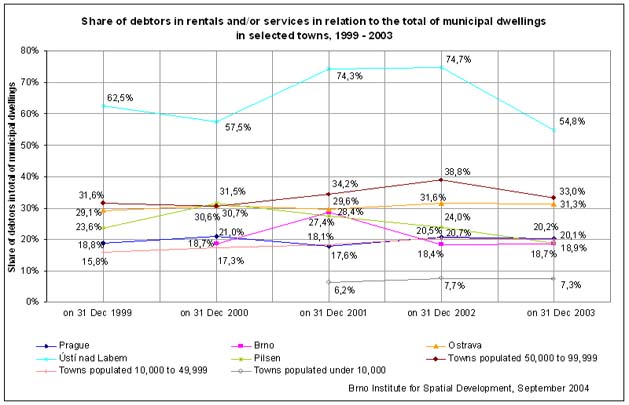
Data on debtors in Ostrava apply to the whole of the city except those registered at the Municipal Office.
Diagram 6
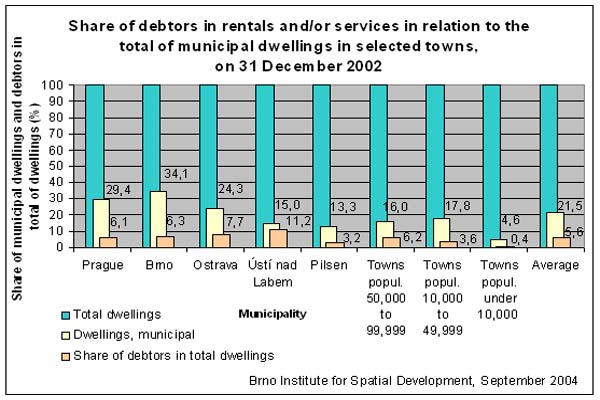
Diagram 7
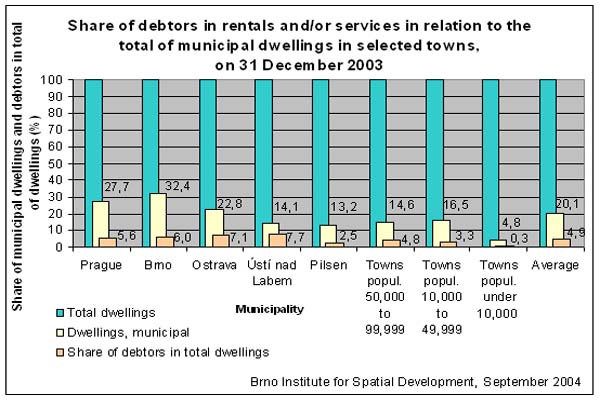
Data on total dwellings as per the census of 1 March 2001.
- The question of the numbers of debtors (in rentals and/or services) who owed payments for the months of November and December of respective years was answered by a few respondents only, as the most frequent system of evidence cannot easily identify short-term debts in specific months. The data in following Chart 2, Share of debtors in November and December of respective years, are therefore rather approximate. Not the arithmetic average but the median is shown here, the latter being more explanatory with the small batch of respondents.
Chart 2
| Municipality | 2002 | 2003 | ||||
| Min | Max | Median | Min | Max | Median | |
| Prague (selected city Districts) | 0.0 % | 84.2 % | 42.1 % | 0.0 % | 53.3 % | 26.8 % |
| Brno (selected city Districts) | 0.0 % | 81.8 % | 45.2 % | 0.0 % | 75.0 % | 41.7 % |
| Ostrava (selected city Districts) | 0.0 % | 100.0 % | 30.1 % | 0.0 % | 100.0 % | 32.5 % |
| Ústí nad Labem (selected city Districts) | 1.5 % | 52.5 % | 27.0 % | 1.2 % | 52.6 % | 26.9 % |
| Pilsen (selected city Districts) | 0.0 % | 50.2 % | 25.1 % | 0.0 % | 49.1 % | 24.5 % |
| Towns populated 50,000 to 99,999 | 24.6 % | 58.6 % | 35.4 % | 19.5 % | 56.2 % | 37.9 % |
| Towns populated 10,000 to 49,999 | 14.5 % | 97.1 % | 32.3 % | 7.5 % | 55.8 % | 25.8 % |
| Towns populated under 10,000 | 0.0 % | 54.3 % | 34.7 % | 2.7 % | 73.9 % | 43.8 % |
- The average net rental per dwelling in 2002 was of CZK 1,507 a month, while in 2003, CZK 1,596 a month.
- The average monthly payment for services per dwelling in 2002 was of CZK 1,468, while in 2003, CZK 1,502.
- So, the average monthly payment for the use of a municipal apartment was of CZK 2,975 in 2002, while of CZK 3,099 in 2003.
Thus the 2003 payments for both the net rental and the services were higher than those of 2002.
- The average debt on the net rental of a municipal apartment was of CZK 1,962 as by 31 December 2002, while of CZK 2,509 as by 31 December 2003.
- The average debt on services in a municipal apartment was of CZK 2,029 as by 31 December 2002, while of CZK 2,397 as by 31 December 2003.
- So, the average debt on the use of a municipal apartment was CZK 3,990 as by 31 December 2002, while of CZK 4,907 as by 31 December 2003.
Thus the 2003 debts for both the net rental and the services were higher than those of 2002.
- The percentages of municipal dwellings for which the maximum basic rent (as determined by the Ministry of Finance), the objectively controlled rent, or the contractual rent are applied, is shown in Diagrams 8, Municipal dwellings by types of applied rental, 2002, and 9, Municipal dwellings by types of applied rental, 2003.
The Diagrams indicate that the share of objectively controlled and contractual rents is increasing, while the share of the maximum basic monthly rent is decreasing.
The share of the dwellings with the maximum basic monthly rent in the towns under observation was 94.7 % in 2002 and 93.5 % in 2003.
The share of the objectively controlled rent was 2.1 % in 2002 and 2.5 % in 2003. Significantly higher is the share of this type for towns populated under 10,000: 21.1 % in 2002 and 20.7 % in 2003.
The share of contractual rent was 3.2 % in 2002 and 4.0 % in 2003. Most contractually rented flats are to be found in Ostrava (5.7 % in 2002 and 8.2 % in 2003) and towns of 50,000 to 99,999 inhabitants (6.0 % in 2002 and 7.7 % in 2003).
Diagram 8
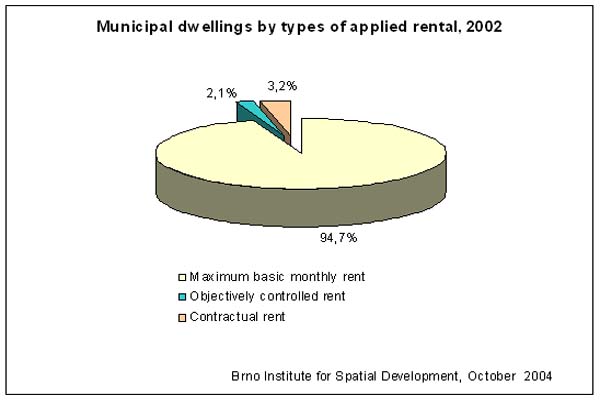
Diagram 9
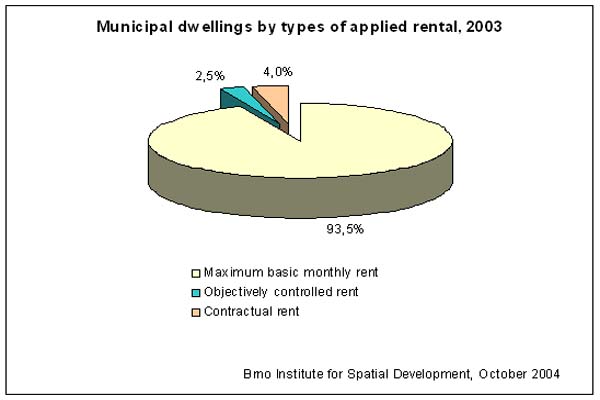
The share of dwellings with contractual rent was of 3.2 % in 2002, while of 4.0 % in 2003. Most of them are found in Ostrava (5.7 % in 2002 and 8.2 % in 2003) and in towns of 50,000 to 99,999 inhabitants (6.0 % in 2002 and 7.7 % in 2003).
- In most cases, Municipalities administer their housing stock through one or more specialized private businesses. If our respondent is responsible for the whole of a city, several caretakers are usually mentioned, while if the respondent is a town or city District, one private business as caretaker is usually mentioned.
- The average monthly costs of the maintenance of a municipal dwelling through a caretaker were of CZK 178 in 2002, while of CZK 185 in 2003. The average costs for dwellings maintained directly by the Municipality’s department were of CZK 125 in 2002, while of CZK 136 in 2003. The maintenance costs are rising. It is yet much cheaper if the Municipality itself is the caretaker of municipal dwellings.
- Both the average administration costs and the income through rents have increased. (The average monthly costs of the Municipality were of CZK 1,575 an apartment in 2002, while of CZK 1,678 in 2003. The average monthly income was of CZK 1,680 in 2002, while of CZK 1,727 in 2003.) Yet, the average costs of administration are lower than the income through rents, which suggests that there are places where the income is sufficient to cover at least some basic repairs of the housing stock. From the viewpoint of privatization, it seems that Municipalities generally try to get rid of buildings which are in poor conditions.
- Diagram 10, Coverage of maintenance costs through rentals, shows the response to the question whether the income is sufficient for caretakers to prevent the buildings from any deterioration of their technical conditions.
Diagram 10
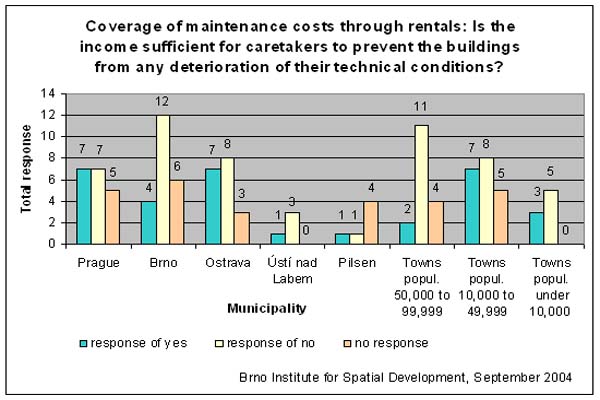
Selected facts from the additional part of the questionnaire
- Of all the 114 respondents, only 7 (i.e. 6 %) do not keep records of applications for the allowance of municipal apartments. These are two Districts of the cities of Brno and Ústí nad Labem, and the Municipalities of Teplice, Hradec Králové, Tábor, Příbram, and Dačice. The other respondents keep their records, some of them filing certain types of apartments only, such as those of special purposes or serving to public benefit (police, fire brigade, apartments for the handicapped, and so forth).
- The percentage of registered applications for municipal dwellings in 2002 and 2003 in all the categories of towns and cities, as related to total numbers of municipal dwellings, and such percentage in total, is shown in Diagram 11, Share of applications for municipal dwellings as related to total numbers of municipal dwellings, 2002 and 2003.
- The percentage of registered applications for municipal dwellings in 2002 and 2003 in all the categories of towns and cities, as related to total numbers of all dwellings (as per the 2001 census), and such percentage in total, is shown in Diagram 12, Share of applications for municipal dwellings as related to total numbers of all dwellings in towns and cities under observation, 2002 and 2003.
Diagram 11
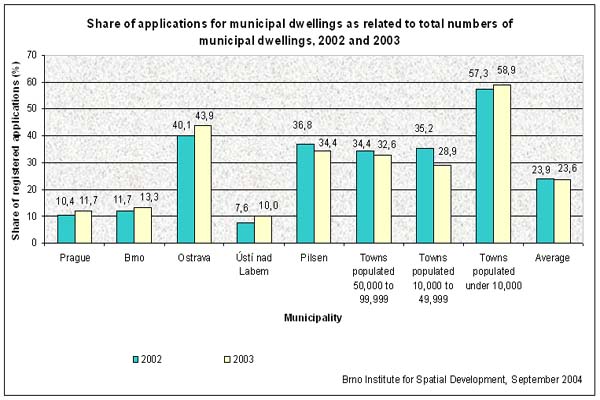
Diagram 12
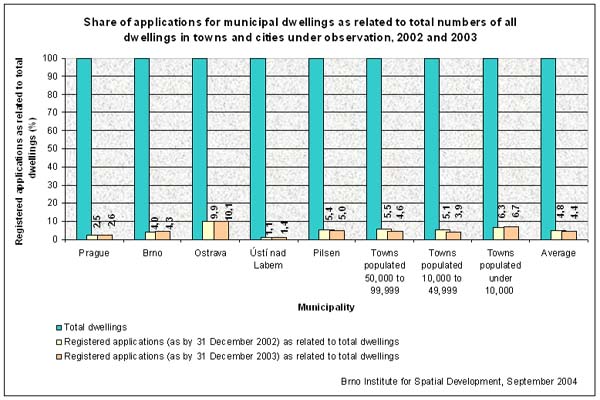
- Merely 3 Municipalities (Hradec Králové, Česká Lípa, Cheb) say they offer remuneration to tenants who return a vacant flat to the Municipality, motivating them to give up unauthorized operations with municipal dwellings.
The issues of municipal housing have been monitored through questionnaire surveys since 2000, then exploring data of 1998 and 1999. The 2001 survey explored data of 1999 and 2000, the 2002 survey did so for 2000 and 2001, last year’s survey was focused on the situation in 2001 and 2002, and this year the focus was on 2002 and 2003. For the assignor of the task - the Ministry of Regional Development’s Department of housing policy - such research is one of the ways to collect up-to-date information on municipal housing, as the Czech Statistic Office does not record such data.
The research of the developments in the privatization of the municipal housing stock offers the comparison of the dynamics of this process between its beginnings in 1991 and today, giving estimations of its prospects and offering information on its future timing. The results of this year’s research have again shown that the termination of the process of the privatization of municipal housing stocks is to be postponed. The most remote dates mentioned in this year’s research were the years 2010 and 2012.
The printed version of the final report of the 2004 questionnaire survey is available at the Housing Policy Department of the Ministry of Regional Development and at the Brno Institute for Spatial Development. Brief results of the research of the developments in municipal housing stocks in 2002 and 2003 are available at the Institute’s web site, www.uur.cz.
Following the requirements of the Ministry of Regional Development, the survey will be repeated at the beginning of 2005. Probably a few more towns of under 10,000 inhabitants will be addressed and some minor changes of the questions in the additional part of the questionnaire are intended.
The task of Monitoring Municipal Housing, comprehensively analysing the municipal housing stock, is an important part of the continuous activities of the Institute for Spatial Development. The results of the annually repeated research are widely used by housing policy makers.
The assignor of the task - the Housing Policy Department of the Ministry of Regional Development - and the researching staff of the Institute for Spatial Development wish to thank all the respondents for their collaborative approach and for the information with which they have contributed to the final report, making thus a coherent picture of the situation of the municipal housing stock in the Czech Republic.

